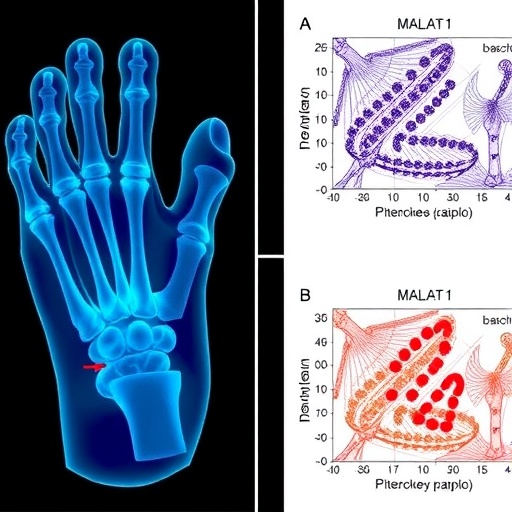In a groundbreaking study that has captured the attention of the scientific community, researchers have unveiled important insights into the role of long non-coding RNA (lncRNA) MALAT1 in the context of diabetic lower limb atherosclerotic disease. This research brings to light a previously overlooked aspect of diabetic complications, emphasizing the intricate interplay of molecular factors that exacerbate these conditions. The findings suggest that targeting MALAT1 could open up new therapeutic avenues for managing diabetic atherosclerosis, a significant concern for millions of individuals suffering from diabetes-related health issues worldwide.
Atherosclerosis, particularly in the lower limbs, poses a severe risk for diabetic patients. As a progressive disease, it is characterized by the accumulation of plaque in the arterial walls, which can lead to reduced blood flow, debilitating pain, and even amputation in severe cases. Traditional treatments have focused on managing blood sugar levels and lifestyle changes, yet they often fall short in addressing the underlying molecular mechanisms driving the disease. Consequently, there is a pressing need for innovative strategies that go beyond conventional approaches.
Central to this study is the exploration of MALAT1, a long non-coding RNA that has emerged as a critical player in various cellular processes, including inflammation and cell death. Researchers have long suspected that MALAT1 might have a significant impact on endothelial cell function—cells that line blood vessels and play a crucial role in vascular health. The researchers set out to investigate how MALAT1 influences pyroptosis, a form of programmed cell death associated with inflammation, particularly in the context of diabetic conditions.
Through a series of meticulously designed experiments, the team conducted knockdown studies to reduce the expression of MALAT1 in endothelial cells derived from diabetic mice. The results were compelling: a noticeable reduction in pyroptosis was observed alongside an improvement in endothelial cell viability. These findings point to a direct relationship between MALAT1 expression levels and the survival of endothelial cells under diabetic conditions.
Furthermore, the researchers delved deeper into the molecular pathways involved, identifying microRNA-17-5p (miR-17-5p) as a key mediator in this process. The intricate regulation between MALAT1 and miR-17-5p became evident as the study revealed that MALAT1 acts as a sponge, sequestering miR-17-5p. This interaction contributes to an environment conducive to endothelial cell pyroptosis when MALAT1 levels are elevated. Thus, the manipulation of this pathway emerges as a promising therapeutic target.
The implications of this research extend beyond mere academic interest. Offering a fresh perspective on the treatment of diabetic atherosclerosis could dramatically alter patient outcomes. By effectively knocking down MALAT1, not only is there a potential to reduce endothelial cell death, but also to improve blood flow and overall limb health in diabetic individuals. This translates to a significant reduction in complications and an enhanced quality of life for those affected.
As healthcare systems globally grapple with rising diabetes prevalence, this research advocates for a shift in therapeutic paradigms. By identifying and targeting specific molecular pathways, such as those involving MALAT1 and miR-17-5p, clinicians may be equipped to design more effective treatments tailored to the underlying mechanisms of diabetic complications.
Moreover, this study paves the way for further exploration into the roles of other long non-coding RNAs in metabolic diseases. The field of RNA biology continues to expand, revealing intricate networks that govern cellular behavior. As scientists uncover more about these molecular players, new opportunities for therapeutic intervention will undoubtedly arise.
In conclusion, the research by Li et al. marks a pivotal moment in our understanding of diabetic lower limb atherosclerosis. The unraveling of the MALAT1-miR-17-5p axis sheds light on a complex yet critical interplay that influences endothelial cell fate. As future studies build on these findings, it is expected that the insights gained will drive forward innovative treatments that address the root causes of diabetic complications rather than merely masking symptoms. What lies ahead could be a new era in diabetes management, one where molecular targeting leads to tangible improvements in patient health and quality of life.
This study not only underscores the importance of basic research but also highlights the urgent need for continued investment in understanding the molecular underpinnings of complex diseases. The quest for solutions in the fight against diabetes is far from over, but with every investigation, we draw closer to effective, life-changing therapies that could one day alleviate the burden of this pervasive disease.
Innovative approaches, such as the one presented in this study, hold the promise of revolutionizing how we view and treat diabetes-related ailments. The potential for therapeutic advancements based on the manipulation of lncRNAs like MALAT1 signifies a forward-thinking approach that could define future research endeavors. As researchers continue to peel back the layers of gene regulation, we may soon witness a transformation in clinical practices that align more closely with the biological realities of disease.
While challenges remain, the findings from this groundbreaking research provide a hopeful outlook for the future of diabetic treatment, emphasizing the vital role of comprehensive research in paving the way for pioneering innovations in healthcare.
Subject of Research: The role of long non-coding RNA MALAT1 in diabetic lower limb atherosclerotic disease.
Article Title: Knockdown of Long Non-coding RNA-MALAT1 Ameliorates Diabetic Lower Limb Atherosclerotic Disease Through MiR-17-5p-Mediated Endothelial Cell Pyroptosis.
Article References:
Li, J., Xu, JX., Wang, C. et al. Knockdown of Long Non-coding RNA-MALAT1 Ameliorates Diabetic Lower Limb Atherosclerotic Disease Through MiR-17-5p-Mediated Endothelial Cell Pyroptosis.
Biochem Genet (2025). https://doi.org/10.1007/s10528-025-11236-7
Image Credits: AI Generated
DOI:
Keywords: Diabetic atherosclerosis, MALAT1, long non-coding RNA, endothelial cells, microRNA-17-5p, pyroptosis, vascular health, diabetes complications.




